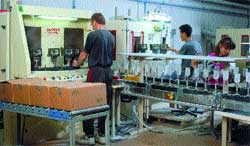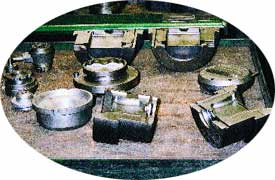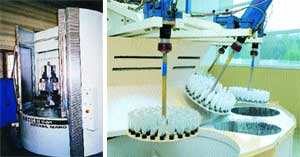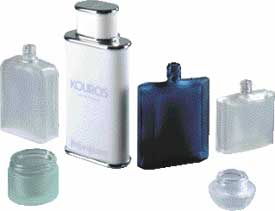Perfume bottle design, decoration is magnifique!
January 29, 2014

For seven centuries, glassmaking has been the raison d'être for a majority of the population in the Vallée de la Bresle in France. Spanning two regions in Northern France–Upper Normandy and Picardy–the valley, through which runs the Bresle River, employs 60 percent of the area's population in glassmaking and complementary services. The region's businesses specialize in creating glass flasks for perfume and cosmetics for some of the world's most renowned perfumeries.
Since 1302, when the first glassworks settled near the Lyons forest, or Lyons la Forêt, the glassmaker was king, supporting and sustaining complementary professions. However, in recent years, businesses such as glass packaging prototype designers, moldmakers and glass bottle decorators have come into their own, providing services not only to the local glassmakers, but also to glass bottle producers worldwide.
|
Semi-automatic machines are used by R. Morel to sandblast only specified areas of a glass bottle. |
"The glass manufacturers [of the Bresle Valley] used to be the 'Lords of the Valley,'" says Guy de Vaucorbeil, president of the Bresle Glass Federation, "but now their subcontractors have enough expertise that they can operate independently."
Among these companies are three model-making/design firms, two foundries, 13 glass moldmakers, and 27 decorators that provide crucial services for the production of 75 percent of the world's glass packaging for perfumes and cosmetics.
On a recent trip to the Bresle Valley, Packaging Digest had the opportunity to visit three of these companies: M.M.B. (Moules, Maquettes de la Bresle), Société Nouvelle de Moulerie (S.N.M.) and R. Morel s.a.r.l., which, respectively, provide prototyping, moldmaking and decorating. A fourth company visited during PD's tour, Saint-Gobain Desjonquères, one of the region's largest glassmakers, was profiled in a previous issue (see PD, May, '03, p. 52).
Super models
Long before a perfume bottle rests upon a cosmetics counter, it goes through a surprisingly complex number of evolutions and refinements that begin with the designer and end with the decorator. The first step in bringing a perfumery's vision to life is the prototype stage, whereby a model-maker converts a sketch of a bottle design into a presentation model made from resin. One such model-maker in the Bresle Valley is M.M.B. (Moules, Maquettes de la Bresle), located in Blangy-sur-Bresle.
M.M.B., founded in '71, provides prototypes and models to a diversified customer base; 70 percent of its business is from automobile component designers, 20 percent from packaging designers, and 10 percent from other sources. For packaging applications, M.M.B. offers rapid prototyping services. Using CAD technology, rapid prototyping speeds the production of a model, allows a packager to identify possible errors in a design before they invest in tools and machinery, and provides a production-ready model for aesthetic validation and approval.
To begin the process, M.M.B. works from sketches fine-tuned by perfume-bottle designers with help from M.M.B. These sketches are manual drawings often modeled in CAD or created directly from their digital definitions. CAD data is then transmitted to a machine operating on the same software that produces a plaster model of the container.
The master model is then placed in a mold constructed of laminated chipboard and is suspended in the middle of the mold with casting rods. Next, the mold is filled with a liquid silicone rubber and placed in either one of two vacuum casting machines, from MCP Rapid Tooling Technologies and another supplier, that use a vacuum operation to degass the silicone.
After being degassed, the mold is placed in an oven for curing. Once cured, the mold is removed and cut open, revealing the master model faithfully reproduced in the silicone. This finished mold is subsequently used to produce a number of resin-based prototypes.
During prototype production, the vacuum casting machine mixes a liquid resin with a catalyzer that will allow the resin to harden, and then pours the mixture into the mold below via a flexible tube. For final forming, the mold is placed in an oven and is heated for about 45 minutes at 70 deg C (158 deg F).
Despite M.M.B.'s use of heavily automated equipment, PD is told by de Vaucorbeil, who was one of PD's escorts for the day-long tour, that of the 48 workers employed at M.M.B., five or six have high-tech backgrounds. "This is very helpful when experimenting with new applications and technologies," he says. "To compete with low-wage countries, we must differentiate ourselves through sophistication and innovation."
|
It takes 11 precisely milled stainless-steel, bronze or nickel-based alloy mold components to make up just one perfume-bottle mold for use in the glassmaker's equipment. |
Not on PD's tour route, but a vital part of the glassmaking process, are the foundries, of which there are two in the Bresle Valley–Caffier et Barreau and Fonderies de la Bresle, both of which are located in Blangy-sur-Bresle. Intervening between the modeler and the moldmaker, the foundry provides the moldmaker with the cast iron used to produce the various parts of a mold.
Other materials supplied by the foundry for use in moldmaking include stainless steel, bronze and nickel-based alloys.
Molding: a precise art
It is said that "a good moldmaker creates a glassmaker's fortune." Indeed, responsible for designing and machining with consistency and extreme precision the molds used to create all types of hollow glass objects to the both the designer's and the glassmaker's specifications, the moldmaker holds the success of each new bottle design in his hands. At Blangy-sur-Bresle's Société Nouvelle de Moulerie (S.N.M.), ISO-9002 certification ensures strict quality and customer service standards. The mold fabricator, with 30 employees covering three shifts daily, seven days a week, and working with a plant full of sophisticated molding equipment, can produce a maximum of up to 300 molds/month. Some of its more famous clients include Chanel, Hermes, Karl Lagerfeld, Liz Claiborne, Nina Ricci and Yves Saint Laurent, among others.
The process of making the mold begins when S.N.M. takes the final drawings and digital dimensions of a new glass container design and transfers them to a CAD/CAM program. This program then drives one of the company's three CNC (computer numerical control) milling machines, which cuts out the mold cavity from two halves of a previously round bar of cast iron. The machines operate horizontally and can accommodate two molds–or four mold halves–at one time, producing very rough molds, ready for further refining.
Meticulously carving out each nook and cranny of a mold cavity to exact specifications is the job of the company's four high-speed, vertical milling machines–Deckel Maho's DMC 50V, DMC 60 H and DMC 60H hi-dyn, and an MV5Cn from Mitsubishi.
During PD's visit, a mold was being milled on one of the Deckel Maho machines. During operation, the machine followed the bottle design's CAD program to select, one after another, the specific tools (out of the 40 available) necessary to "chisel" out each edge and area of the cavity. A constant spray of water onto the cavity surface reduces changes in tool performance due to high temperatures.
|
A high-speed vertical CNC milling machine, left, is loaded with two halves of a roughly carved mold for precise milling, driven by a CAD/CAM program of the perfume bottle design. After being produced by the glassmaker, perfume bottles are decorated by being submerged in an automatic acid bath, right. |
Other mold components are created separately, such as the bottom plate, which undergoes a process of sandblasting and welding at temperatures up to 500 deg C. In all, the final mold comprises up to 11 separate pieces. According to Jean-Luc Morel, gérant, or manager, of S.N.M., molds can cost anywhere from ?20,000 to ?40,000 (U.S.$21,000 to $42,000) apiece, depending upon the complexity of the bottle design. Usually, a perfumery will order one to two prototype molds, Morel says, followed by anywhere from eight to 20 molds for use in the glass production environment.
The final touch
At R. Morel s.a.r.l., a decorating firm located in Gamaches, in Normandy, 95 percent of its business is dependent upon the nearby glass factories. The company, which has 85 employees and a 5,000-sq-m (54,000-sq-ft) production facility, provides acid etching and sandblasting of glass bottles with six automatic and four semi-automatic lines, respectively.
Acid etching is a chemical process whereby the outer layers of a glass container are removed to give the bottle an opaque, frosted appearance, with a smooth finish. Explains Jack Tirolien, assistant director of R. Morel, "The process is not used to hide imperfections. It is used to decorate the bottles." However, during the acid-etching process, a seam, or raised line along the length of the bottle from the bottle mold, is removed.
|
R. Morel decorates a range of bottle shapes and sizes through acid-etching and sandblasting on automatic and semi-automatic machines, respectively. |
During acid etching, bottles are manually placed upside down on a round carrier, with their openings fitted onto custom-designed rubber plugs that prevent any acid from entering the bottle. The bottles are then submerged–either manually, or automatically, on the larger machines–in a fluoride acid bath for anywhere from 35 to 40 seconds. Immediately after removal from the bath, the bottles are rinsed twice, the second time with purified water that removes any remaining stains on the bottle. Bottles are then manually unloaded from the carrier, their openings are wiped down, and they are sent through a dryer before being hand-packed into shipping cases. Finished bottles are placed in storage for distribution, which usually takes place within eight days, says Tirolien.
Sandblasting, which provides a similar, "cloudy" effect, is used to decorate only specific parts of a bottle. The areas not receiving decoration are covered with a resin tool, custom-made at R. Morel. During the semi-automatic operation, the containers, ranging in size from 1 to 2 cc up to 0.5 L, are placed upside down on a conveying line, with their openings protected by rubber plugs. Operators take the bottles and manually load them into the decorating machine, fitting them with the resin tool. In the company's four Guyson Multiblast® automated blast systems, artificial sand is projected onto the bottles' exposed areas with compressed air. Guyson Marr-Line® multiple-stage conveyorized wash/dry systems are then used to rinse and dry the bottles prior to hand-packing into corrugated cases.
Estimates Tirolien, from 30 to 35 million bottles per year are decorated at R. Morel, which has been a part of the Bresle Valley's glass perfume-bottle production tradition since 1968.
More information is available:
Association: Bresle Glass Federation, 33 (0)2 35 82 20 20. Circle No. 249.
Model-maker: M.M.B. (Moules, Maquettes de la Bresle), 33 (0)2 32 97 53 21. Circle No. 250.
Vacuum casting machines: MCP Systems, 203/368-4787. Circle No. 251.
Moldmaking: S.N.M. (Société Nouvelle de Moulerie), 33 (0)2 35 94 65 14. Circle No. 252.
Milling machines: Dekel Maho Geretsried GmbH, 49(0)8171 817 0. Circle No. 253.
Milling machine: Mitsubishi Heavy Industries America, Inc., Machine Tool Div., 630/693-4700. Circle No. 254.
Glass decorator: R. Morel s.a.r.l., 33 (0)3 22 60 21 00. Circle No. 255.
Blast systems, washer/dryers: The Guyson Corp. of USA, 518/587-7894. Circle No. 256.
About the Author(s)
You May Also Like






